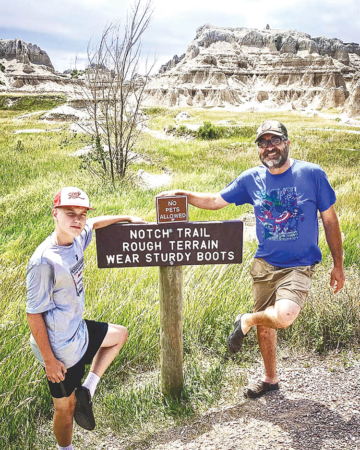Happy Trails, kids. My family and I are currently in South Dakota. We are here for a few more days; then, it is back to Pennsylvania. I have traveled here many times, but I continue to admire and appreciate the beauty. The landscapes are insane. We live in a beautiful country.
Badlands is a national park in southwestern South Dakota. The rugged beauty of the Badlands draws visitors from around the globe. The peaks, gullies, and buttes resulted from an ancient waterway molded by wind and erosion. The coloring is incredible. The ruggedness is impressive. The Badlands gives one a sense of wonder. There are no words to describe the sudden change in landscape. The American frontier. Ever seen the movie “Dances with Wolves?” Yes. It is one of my all-time favorites. Most of Kevin Costner’s gem was actually filmed in the Badlands. This place is amazing. These striking geologic phenomenons contain one of the world’s richest fossil beds. Ancient horses and rhinos once roamed here. The park’s massive area protects the largest undisturbed mixed-grass prairie in the entire United States. Bison, bighorn sheep, prairie dogs, and black-footed ferrets now thrive.
The name is an homage to the people who once lived here. For hundreds of years, the Lakotas called this area ‘Mako Sica,’ which literally translates to “bad lands.” When early French fur trappers passed through, they referred to her as les mauvaises terres a traveser (bad lands to travel across). The Badlands presented many challenges for those early settlers. Rains made the clay slick and sticky. Impassible. The jagged canyons and buttes that cover the terrain also make it hard to navigate. The winters are brutally cold and windy, the summers are hot and dry, and the few water sources were unsafe to drink. These factors make the land extremely difficult to survive in. Evidence of early human activity points to seasonal hunting rather than actual habitation.
This area was originally the lands of the Oglala Sioux. And in 1868, at the Second Treaty of Fort Laramie, the United States assured the Sioux that the Badlands shall forever be in their possession. In 1889, however, the treaty was broken, and the Badlands were confiscated by the United States. Sioux Indians objected and caused a stir. Thousands assembled in 1890, and via a Ghost Dance, they tried to revive the souls of the lost buffalo and the dead.
The history of the Badlands as a significant paleontological resource goes back to the times of the Lakotas. They found large fossilized bones, fossilized seashells, and turtle shells. They correctly assumed that the area had once been underwater and that the bones belonged to creatures that no longer existed. In 1843 a fossilized jaw fragment collected by Alexander Culbertson of the American Fur Company found its way to a physician in St. Louis. Hiram A. Prout published a paper about the jaw in the American Journal of Science in which he stated that it had come from a creature he called a Paleotherium. Shortly after the publication, the Badlands became an extremely popular fossil hunting grounds. By 1854 it was said that 84 distinct species had been discovered in North America and 77 of which were found in the South Dakota Badlands. Throughout the late 19th century and continuing today, scientists and institutions from all over the world have benefited from the resources of the Badlands.
I highly recommend a visit. Jensen and I enjoyed a lengthy hike and some wild scenery. Special thanks to my Uncle Chuck and Aunt Deb from Pipestone for their hospitality and accommodations. Cheers.




